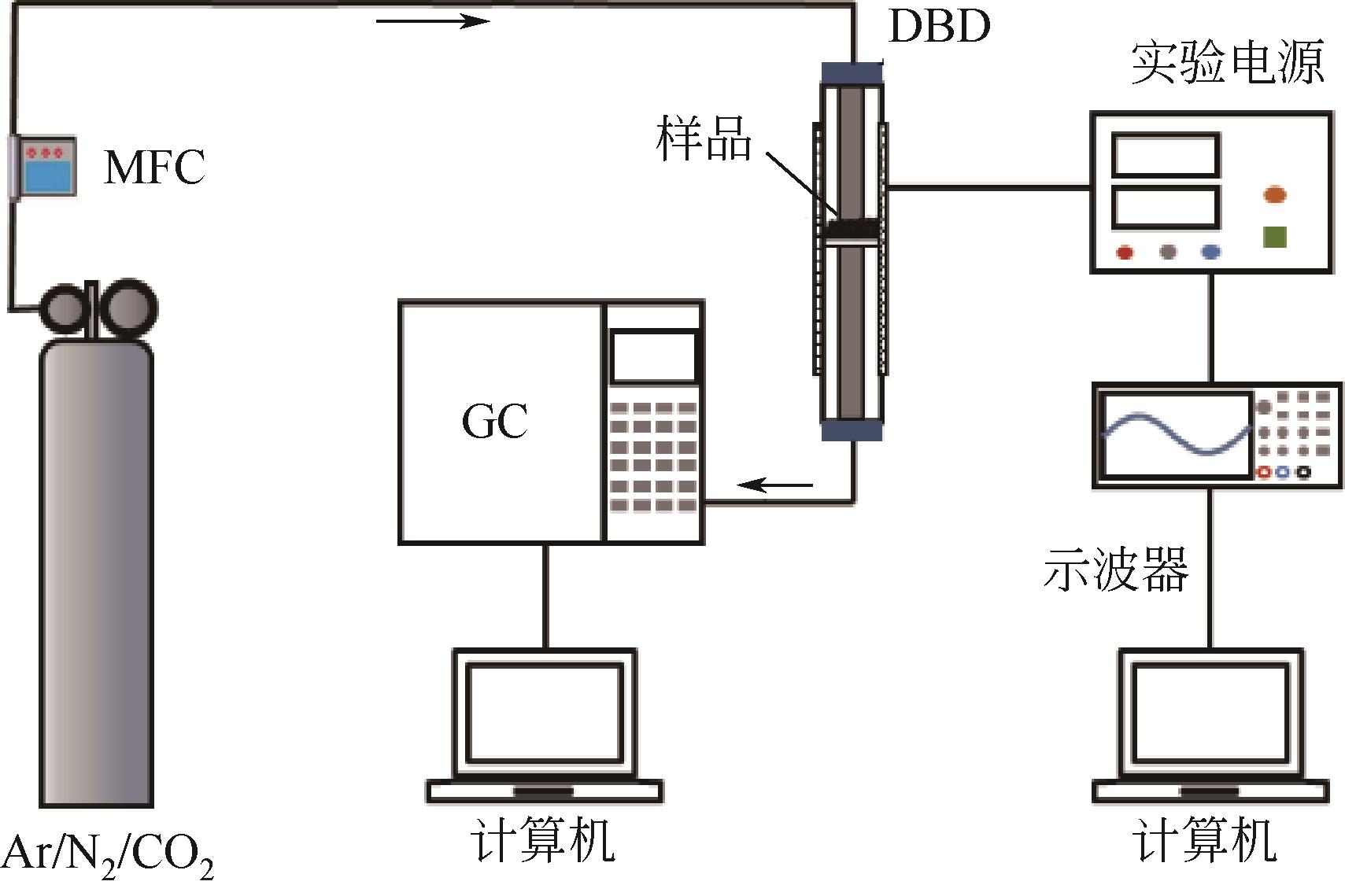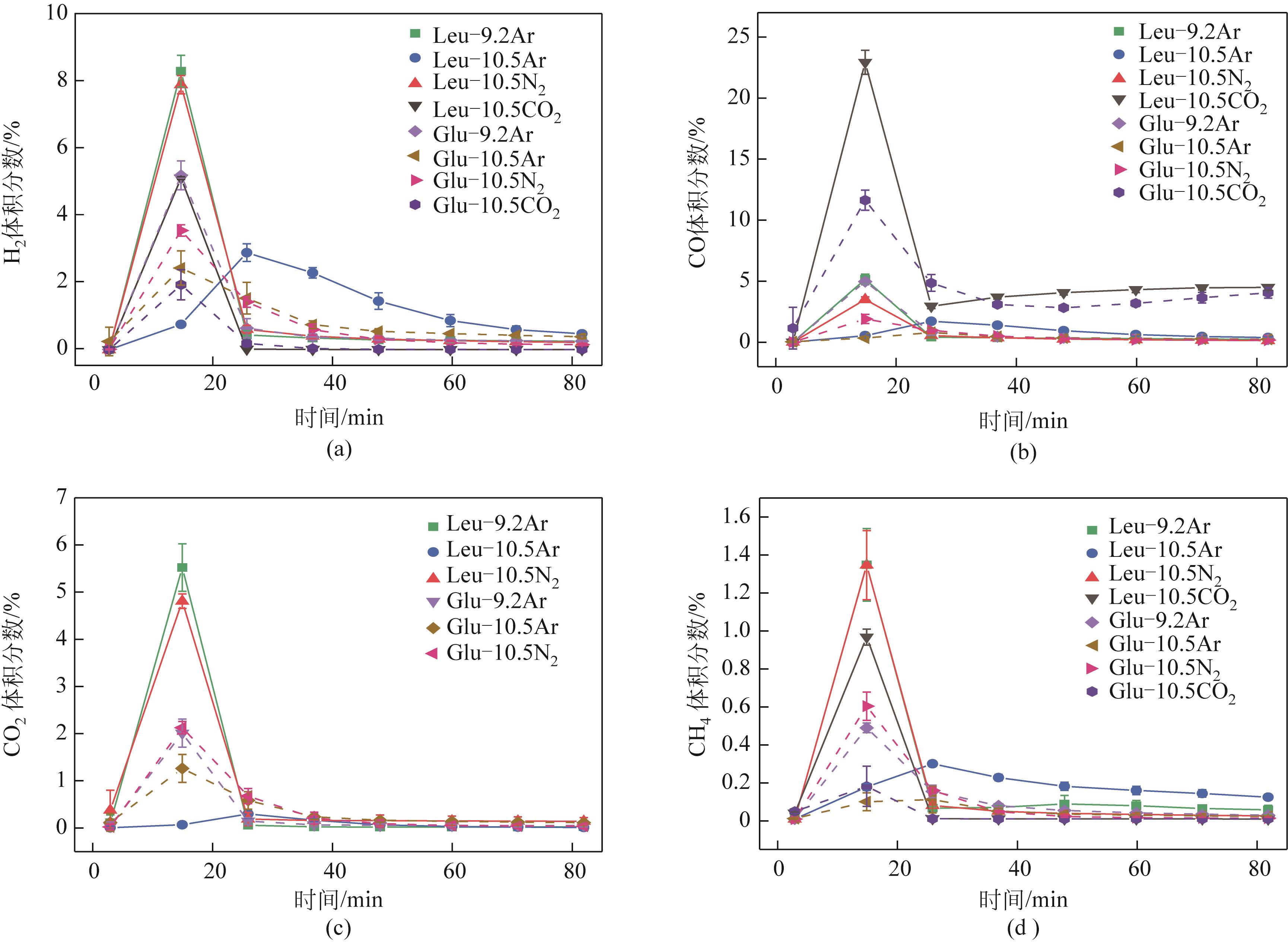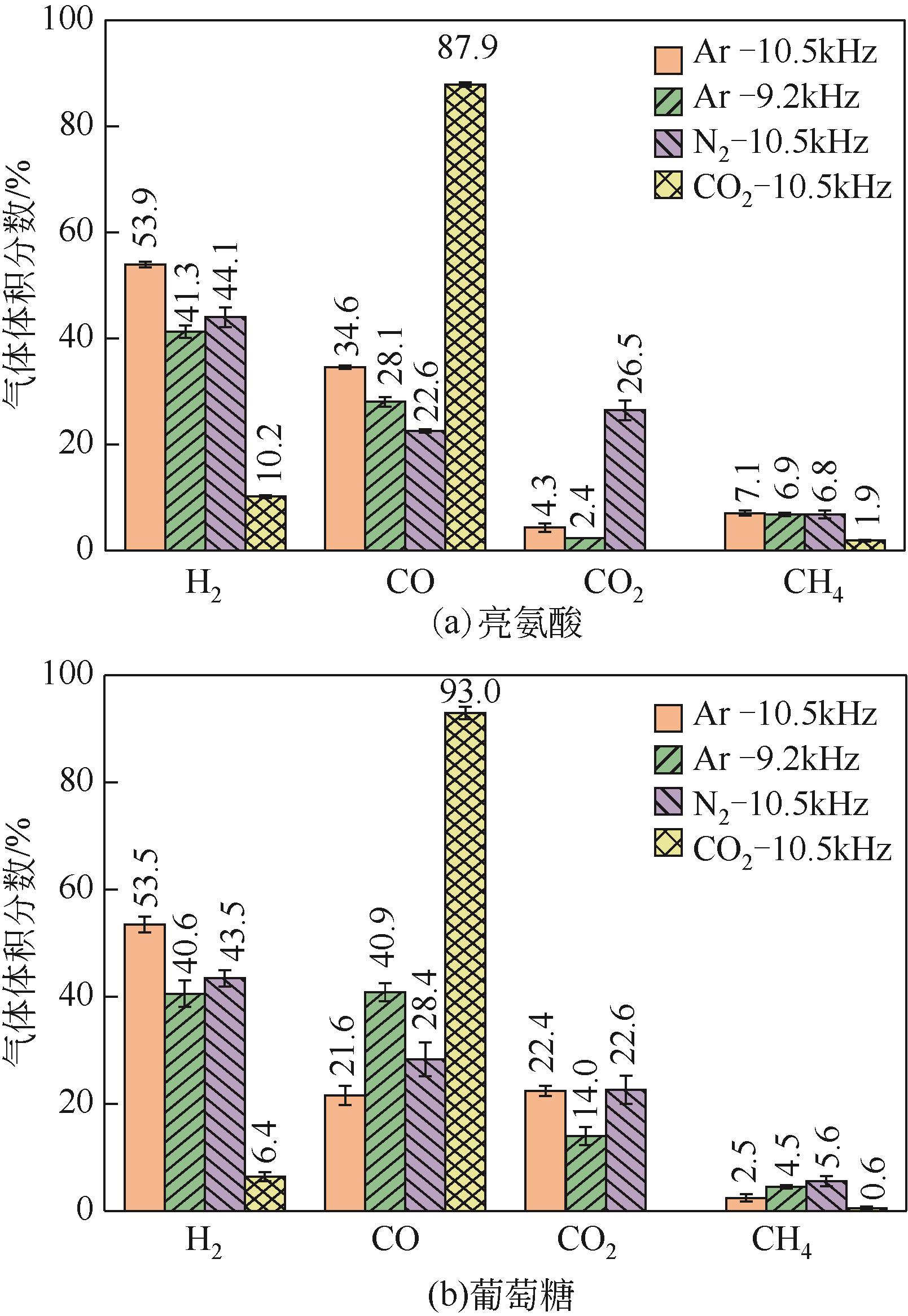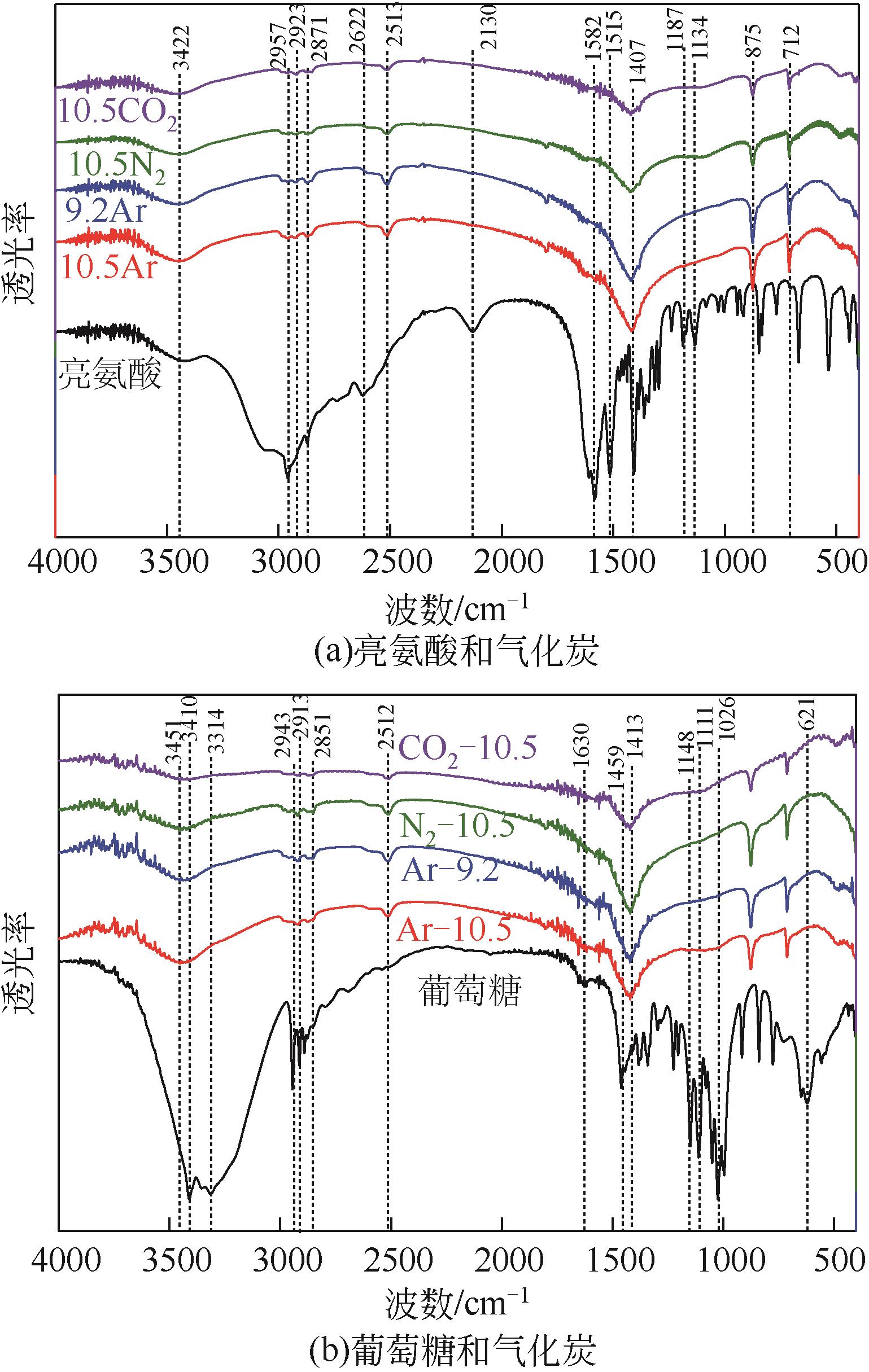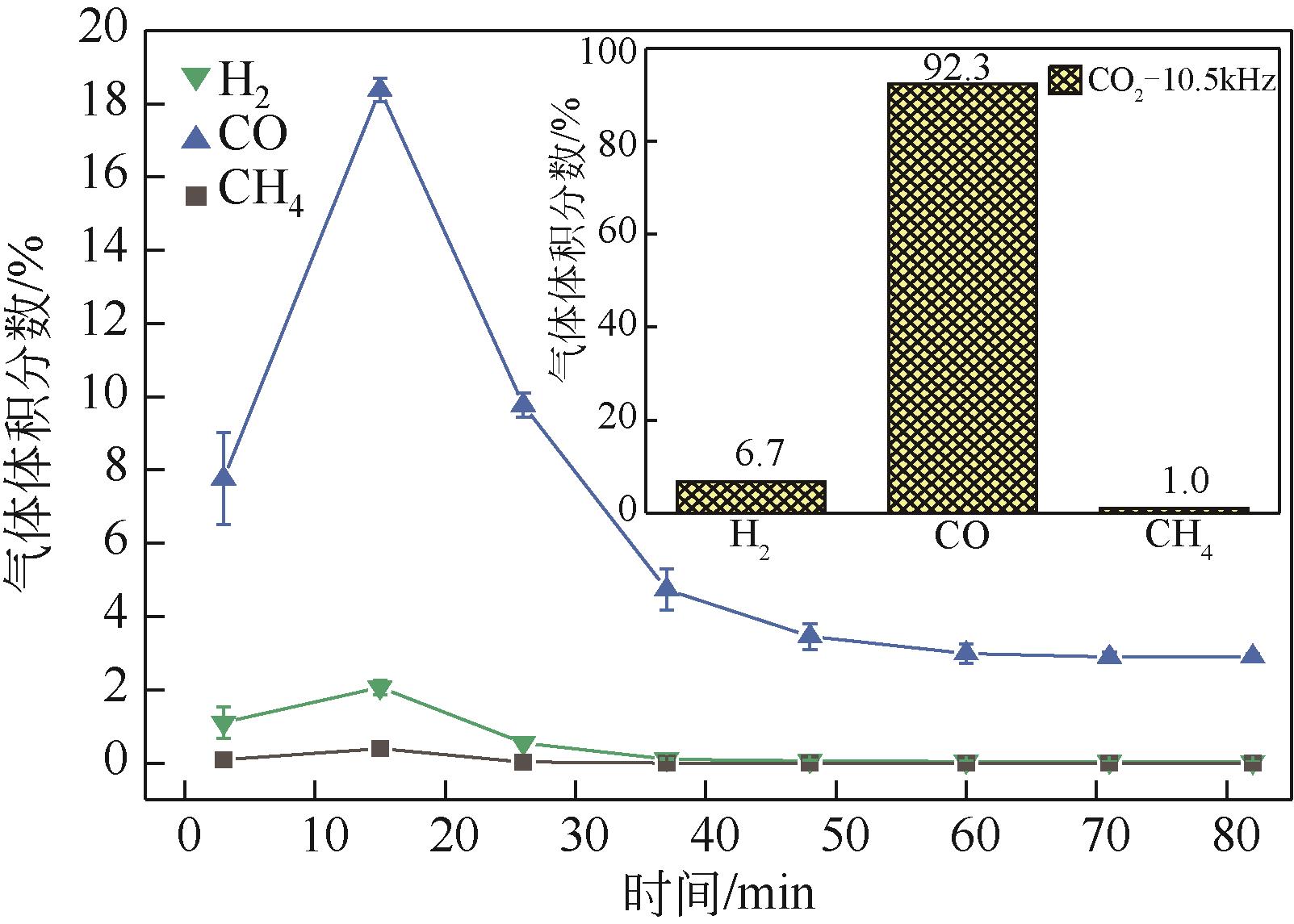Chemical Industry and Engineering Progress ›› 2022, Vol. 41 ›› Issue (4): 2150-2160.DOI: 10.16085/j.issn.1000-6613.2021-0810
• Resources and environmental engineering • Previous Articles Next Articles
Gasification of sewage sludge and its model compounds with NTP-DBD: effect of atmosphere on product distribution and properties
WANG Siyi( ), LI Yuehui, GE Yujie, WANG Huanran, ZHAO Lulu, LI Xianchun(
), LI Yuehui, GE Yujie, WANG Huanran, ZHAO Lulu, LI Xianchun( )
)
- School of Chemical Engineering, University of Science and Technology Liaoning, Anshan 114051, Liaoning, China
-
Received:2021-04-16Revised:2021-05-22Online:2022-04-25Published:2022-04-23 -
Contact:LI Xianchun
NTP-DBD气化城市污泥及其模型化合物: 气氛对产物分布及特性的影响
王思怡( ), 李月慧, 葛玉洁, 王焕然, 赵璐璐, 李先春(
), 李月慧, 葛玉洁, 王焕然, 赵璐璐, 李先春( )
)
- 辽宁科技大学化学工程学院,辽宁 鞍山 114051
-
通讯作者:李先春 -
作者简介:王思怡(1987—),女,博士研究生,研究方向为固体废弃物处理技术与理论。E-mail:13029372008@126.com 。 -
基金资助:国家自然科学基金(U1910215)
CLC Number:
Cite this article
WANG Siyi, LI Yuehui, GE Yujie, WANG Huanran, ZHAO Lulu, LI Xianchun. Gasification of sewage sludge and its model compounds with NTP-DBD: effect of atmosphere on product distribution and properties[J]. Chemical Industry and Engineering Progress, 2022, 41(4): 2150-2160.
王思怡, 李月慧, 葛玉洁, 王焕然, 赵璐璐, 李先春. NTP-DBD气化城市污泥及其模型化合物: 气氛对产物分布及特性的影响[J]. 化工进展, 2022, 41(4): 2150-2160.
share this article
Add to citation manager EndNote|Ris|BibTeX
URL: https://hgjz.cip.com.cn/EN/10.16085/j.issn.1000-6613.2021-0810
| 工业分析(质量分数)/% | 元素分析(质量分数)/% | |||||||
|---|---|---|---|---|---|---|---|---|
| Vd | FCd | Ad | Cd | Hd | Od① | Nd | Sd | |
| 38.38 | 3.65 | 57.97 | 17.03 | 3.08 | 16.83 | 2.90 | 2.19 | |
| 工业分析(质量分数)/% | 元素分析(质量分数)/% | |||||||
|---|---|---|---|---|---|---|---|---|
| Vd | FCd | Ad | Cd | Hd | Od① | Nd | Sd | |
| 38.38 | 3.65 | 57.97 | 17.03 | 3.08 | 16.83 | 2.90 | 2.19 | |
| 气氛 | 放电频率 /kHz | 放电功率P/W | 能量密度SED /J·L-1 | 输出电压 /kV | 气化率 /% | 最高温度 /℃ |
|---|---|---|---|---|---|---|
| Ar | 10.5 | 6.09 | 9128.38 | 16.2 | 3.75 | 92 |
| Ar | 9.2 | 9.25 | 13881.25 | 22.0 | 18.77 | 160 |
| N2 | 10.5 | 12.33 | 18489.99 | 24.0 | 22.79 | 217 |
| CO2 | 10.5 | 13.06 | 20406.43 | 24.4 | 28.73 | 228 |
| 气氛 | 放电频率 /kHz | 放电功率P/W | 能量密度SED /J·L-1 | 输出电压 /kV | 气化率 /% | 最高温度 /℃ |
|---|---|---|---|---|---|---|
| Ar | 10.5 | 6.09 | 9128.38 | 16.2 | 3.75 | 92 |
| Ar | 9.2 | 9.25 | 13881.25 | 22.0 | 18.77 | 160 |
| N2 | 10.5 | 12.33 | 18489.99 | 24.0 | 22.79 | 217 |
| CO2 | 10.5 | 13.06 | 20406.43 | 24.4 | 28.73 | 228 |
| 气氛 | 放电频率 /kHz | 放电功率P /W | 能量密度SED /J·L-1 | 输出电压 /kV | 最高温度 /℃ |
|---|---|---|---|---|---|
| Ar | 10.5 | 6.77/5.95 | 10149/11919 | 16.0/16.8 | 136/137 |
| Ar | 9.2 | 12.28/11.27 | 18430/16912 | 22.4/22.8 | 167/181 |
| N2 | 10.5 | 15.89/13.78 | 23841/20676 | 24.8/24.4 | 199/206 |
| CO2 | 10.5 | 16.04/15.88 | 24060/23816 | 25.6/25.6 | 218/213 |
| 气氛 | 放电频率 /kHz | 放电功率P /W | 能量密度SED /J·L-1 | 输出电压 /kV | 最高温度 /℃ |
|---|---|---|---|---|---|
| Ar | 10.5 | 6.77/5.95 | 10149/11919 | 16.0/16.8 | 136/137 |
| Ar | 9.2 | 12.28/11.27 | 18430/16912 | 22.4/22.8 | 167/181 |
| N2 | 10.5 | 15.89/13.78 | 23841/20676 | 24.8/24.4 | 199/206 |
| CO2 | 10.5 | 16.04/15.88 | 24060/23816 | 25.6/25.6 | 218/213 |
| 1 | RAHEEM A, SIKARWAR V S, HE J, et al. Opportunities and challenges in sustainable treatment and resource reuse of sewage sludge: a review[J]. Chemical Engineering Journal, 2018, 337: 616-641. |
| 2 | 中国环保产业协会. 中国环保产业发展状况报告(2018)[EB/OL]. [2019-01-23]. . |
| China Association of Environmental Protection Industry. A report on the development of environmental protection industry in China(2018)[EB/OL].[2019-01-23].. | |
| 3 | WANG C Q, WANG W L, LIN L T, et al. A stepwise microwave synergistic pyrolysis approach to produce sludge-based biochars: feasibility study simulated by laboratory experiments[J]. Fuel, 2020, 272: 117628. |
| 4 | NAQVI S R, TARIQ R, HAMEED Z, et al. Pyrolysis of high-ash sewage sludge: thermo-kinetic study using TGA and artificial neural networks[J]. Fuel, 2018, 233: 529-538. |
| 5 | KOENIG A, KAY J N, WAN I M. Physical properties of dewatered wastewater sludge for landfilling[J]. Water Science and Technology, 1996, 34(3/4): 533-540. |
| 6 | 杨明沁, 解立平, 岳俊楠, 等. 污水污泥气化焦油热解特性的研究[J]. 化工进展, 2015, 34(5): 1472-1478. |
| YANG Mingqin, XIE Liping, YUE Junnan, et al. Study on the pyrolysis properties of the tars from sewage sludge gasification[J]. Chemical Industry and Engineering Progress, 2015, 34(5): 1472-1478. | |
| 7 | BARRY D, BARBIERO C, BRIENS C, et al. Pyrolysis as an economical and ecological treatment option for municipal sewage sludge[J]. Biomass and Bioenergy, 2019, 122: 472-480. |
| 8 | BECKINGHAUSEN A, REYNDERS J, MERCKEL R, et al. Post-pyrolysis treatments of biochars from sewage sludge and A. Mearnsii for ammonia (NH4-N) recovery[J]. Applied Energy, 2020, 271: 115212. |
| 9 | BAO D D, LI Z W, LIU X, et al. Biochar derived from pyrolysis of oily sludge waste: structural characteristics and electrochemical properties[J]. Journal of Environmental Management, 2020, 268: 110734. |
| 10 | SONG Y Y, HU J W, LIU J Y, et al. CO2-assisted co-pyrolysis of textile dyeing sludge and hyperaccumulator biomass: dynamic and comparative analyses of evolved gases, bio-oils, biochars, and reaction mechanisms[J]. Journal of Hazardous Materials, 2020, 400: 123190. |
| 11 | FURNESS D T, HOGGETT L A, JUDD S J. Thermochemical treatment of sewage sludge[J]. Water and Environment Journal, 2000, 14(1): 57-65. |
| 12 | LIU Y, RAN C M, SIYAL A A, et al. Comparative study for fluidized bed pyrolysis of textile dyeing sludge and municipal sewage sludge[J]. Journal of Hazardous Materials, 2020, 396: 122619. |
| 13 | MANARA P, ZABANIOTOU A. Towards sewage sludge based biofuels via thermochemical conversion: a review[J]. Renewable and Sustainable Energy Reviews, 2012, 16(5): 2566-2582. |
| 14 | 屈广周, 李杰, 梁东丽, 等. 低温等离子体技术处理难降解有机废水的研究进展[J]. 化工进展, 2012, 31(3): 662-670. |
| QU Guangzhou, LI Jie, LIANG Dongli, et al. Research progress in organic wastewater treatment by low-temperature plasma discharge technology[J]. Chemical Industry and Engineering Progress, 2012, 31(3): 662-670. | |
| 15 | HLINA M, HRABOVSKY M, KAVKA T, et al. Production of high quality syngas from argon/water plasma gasification of biomass and waste[J]. Waste Management, 2014, 34(1): 63-66. |
| 16 | SPYROU N, AMORIM J D. Atmospheric pressure DBD low-temperature plasma reactor for the treatment of sugarcane bagasse[J]. IEEE Transactions on Plasma Science, 2019, 47(3): 1583-1592. |
| 17 | DU C M, WU J, MA D Y, et al. Gasification of corn cob using non-thermal arc plasma[J]. International Journal of Hydrogen Energy, 2015, 40(37): 12634-12649. |
| 18 | 孙世翼. 放电等离子体强化处理污泥减量及重金属去除[D]. 兰州: 西北师范大学, 2018. |
| SUN Shiyi. Discharge plasma enhanced sludge reduction and heavy metal removal[D]. Lanzhou: Northwest Normal University, 2018. | |
| 19 | 郑燕, 李明, 朱锡锋. 城市污水污泥催化快速热解制备芳香烃和烯烃[J]. 化工学报, 2016, 67(11): 4802-4807. |
| ZHENG Yan, LI Ming, ZHU Xifeng. Fast catalytic pyrolysis of sewage sludge to produce aromatic hydrocarbons and olefins[J]. CIESC Journal, 2016, 67(11): 4802-4807. | |
| 20 | CHEN S S, DONG B, DAI X H, et al. Effects of thermal hydrolysis on the metabolism of amino acids in sewage sludge in anaerobic digestion[J]. Waste Management, 2019, 88: 309-318. |
| 21 | SUBRAHMANYAM P V R, AN C, SASTRY E, et al. Amino acids in sewage sludges[J]. Journal (Water Pollution Control Federation), 1960, 32(4): 344-350. |
| 22 | 张军. 微波热解污水污泥过程中氮转化途径及调控策略[D]. 哈尔滨: 哈尔滨工业大学, 2013. |
| ZHANG Jun. Nitrogen conversion and control of nitrogen-containing compounds during microwave pyrolysis of sewage sludge[D]. Harbin: Harbin Institute of Technology, 2013. | |
| 23 | AZADI P, AFIF E, FOROUGHI H, et al. Catalytic reforming of activated sludge model compounds in supercritical water using nickel and ruthenium catalysts[J]. Applied Catalysis B: Environmental, 2013, 134/135: 265-273. |
| 24 | WANG C Y, FAN Y J, HORNUNG U, et al. Char and tar formation during hydrothermal treatment of sewage sludge in subcritical and supercritical water: effect of organic matter composition and experiments with model compounds[J]. Journal of Cleaner Production, 2020, 242: 118586. |
| 25 | WEI F, CAO J P, ZHAO X Y, et al. Formation of aromatics and removal of nitrogen in catalytic fast pyrolysis of sewage sludge: a study of sewage sludge and model amino acids[J]. Fuel, 2018, 218: 148-154. |
| 26 | 宋长忠, 方梦祥, 余春江, 等. 杉木热解及燃烧特性热天平模拟试验研究[J]. 燃料化学学报, 2005, 33(1): 68-73. |
| SONG Changzhong, FANG Mengxiang, YU Chunjiang, et al. Study on the characteristics of fir pyrolysis and combustion in thermal balance for simulating typical fire condition[J]. Journal of Fuel Chemistry and Technology, 2005, 33(1): 68-73. | |
| 27 | YIN Q Q, LIU M T, REN H P. Biochar produced from the co-pyrolysis of sewage sludge and walnut shell for ammonium and phosphate adsorption from water[J]. Journal of Environmental Management, 2019, 249: 109410. |
| 28 | MANYÀ J J. Pyrolysis for biochar purposes: a review to establish current knowledge gaps and research needs[J]. Environmental Science & Technology, 2012, 46(15): 7939-7954. |
| 29 | AHMAD M, RAJAPAKSHA A U, LIM J E, et al. Biochar as a sorbent for contaminant management in soil and water: a review[J]. Chemosphere, 2014, 99: 19-33. |
| 30 | WESENBEECK S VAN, PRINS W, RONSSE F, et al. Sewage sludge carbonization for biochar applications. Fate of heavy metals[J]. Energy & Fuels, 2014, 28(8): 5318-5326. |
| 31 | 左薇. 污水污泥微波热解制取燃料及微晶玻璃工艺与机制研究[D]. 哈尔滨: 哈尔滨工业大学, 2011. |
| ZUO Wei. Research on utilization of sewage sludge to produce fuel and glass-ceramics by microwave pyrolysis[D]. Harbin: Harbin Institute of Technology, 2011. | |
| 32 | 于跃芹, 刘永军. 有机化学[M]. 2版. 北京: 科学出版社, 2018. |
| YU Yueqin, LIU Yongjun. Organic chemistry[M]. 2nd ed. Beijing: Science Press, 2018. |
| [1] | SHAO Boshi, TAN Hongbo. Simulation on the enhancement of cryogenic removal of volatile organic compounds by sawtooth plate [J]. Chemical Industry and Engineering Progress, 2023, 42(S1): 84-93. |
| [2] | ZHU Jie, JIN Jing, DING Zhenghao, YANG Huipan, HOU Fengxiao. Modification of CaSO4 oxygen carrier by Zhundong coal ash in chemical looping gasification and its mechanism [J]. Chemical Industry and Engineering Progress, 2023, 42(9): 4628-4635. |
| [3] | LI Zhiyuan, HUANG Yaji, ZHAO Jiaqi, YU Mengzhu, ZHU Zhicheng, CHENG Haoqiang, SHI Hao, WANG Sheng. Characterization of heavy metals during co-pyrolysis of sludge with PVC [J]. Chemical Industry and Engineering Progress, 2023, 42(9): 4947-4956. |
| [4] | ZHANG Lihong, JIN Yaoru, CHENG Fangqin. Resource utilization of coal gasification slag [J]. Chemical Industry and Engineering Progress, 2023, 42(8): 4447-4457. |
| [5] | LI Haidong, YANG Yuankun, GUO Shushu, WANG Benjin, YUE Tingting, FU Kaibin, WANG Zhe, HE Shouqin, YAO Jun, CHEN Shu. Effect of carbonization and calcination temperature on As(Ⅲ) removal performance of plant-based Fe-C microelectrolytic materials [J]. Chemical Industry and Engineering Progress, 2023, 42(7): 3652-3663. |
| [6] | YAO Liming, WANG Yazhuo, FAN Honggang, GU Qing, YUAN Haoran, CHEN Yong. Treatment status of kitchen waste and its research progress of pyrolysis technology [J]. Chemical Industry and Engineering Progress, 2023, 42(7): 3791-3801. |
| [7] | LU Yang, ZHOU Jinsong, ZHOU Qixin, WANG Tang, LIU Zhuang, LI Bohao, ZHOU Lingtao. Leaching mechanism of Hg-absorption products on CeO2/TiO2 sorbentsin syngas [J]. Chemical Industry and Engineering Progress, 2023, 42(7): 3875-3883. |
| [8] | ZHANG Shan, ZHONG Zhaoping, YANG Yuxuan, DU Haoran, LI Qian. Enrichment of heavy metals in pyrolysis of municipal solid waste by phosphate modified kaolin [J]. Chemical Industry and Engineering Progress, 2023, 42(7): 3893-3903. |
| [9] | LI Dongxian, WANG Jia, JIANG Jianchun. Producing biofuels from soapstock via pyrolysis and subsequent catalytic vapor-phase hydrotreating process [J]. Chemical Industry and Engineering Progress, 2023, 42(6): 2874-2883. |
| [10] | ZHENG Xin, JIA Li, WANG Yanlin, ZHANG Jingchao, CHEN Shihu, QIAO Xiaolei, FAN Baoguo. Effect of sewage sludge mixed with coal slime on heavy metal retention characteristics [J]. Chemical Industry and Engineering Progress, 2023, 42(6): 3233-3241. |
| [11] | XIU Haoran, WANG Yungang, BAI Yanyuan, ZOU Li, LIU Yang. Combustion characteristics and ash melting behavior of Zhundong coal/municipal sludge blended combustion [J]. Chemical Industry and Engineering Progress, 2023, 42(6): 3242-3252. |
| [12] | LI Ruolin, HE Shaolin, YUAN Hongying, LIU Boyue, JI Dongli, SONG Yang, LIU Bo, YU Jiqing, XU Yingjun. Effect of in-situ pyrolysis on physical properties of oil shale and groundwater quality [J]. Chemical Industry and Engineering Progress, 2023, 42(6): 3309-3318. |
| [13] | WANG Zhiwei, GUO Shuaihua, WU Mengge, CHEN Yan, ZHAO Junting, LI Hui, LEI Tingzhou. Recent advances on catalytic co-pyrolysis of biomass and plastic [J]. Chemical Industry and Engineering Progress, 2023, 42(5): 2655-2665. |
| [14] | LIANG Yijing, MA Yan, LU Zhanfeng, QIN Fusheng, WAN Junjie, WANG Zhiyuan. Experimental investigation on the anti-coking performance of La1-x Sr x MnO3 perovskite coating [J]. Chemical Industry and Engineering Progress, 2023, 42(4): 1769-1778. |
| [15] | LIU Jing, LIN Lin, ZHANG Jian, ZHAO Feng. Research progress in pore size regulation and electrochemical performance of biomass-based carbon materials [J]. Chemical Industry and Engineering Progress, 2023, 42(4): 1907-1916. |
| Viewed | ||||||
|
Full text |
|
|||||
|
Abstract |
|
|||||
